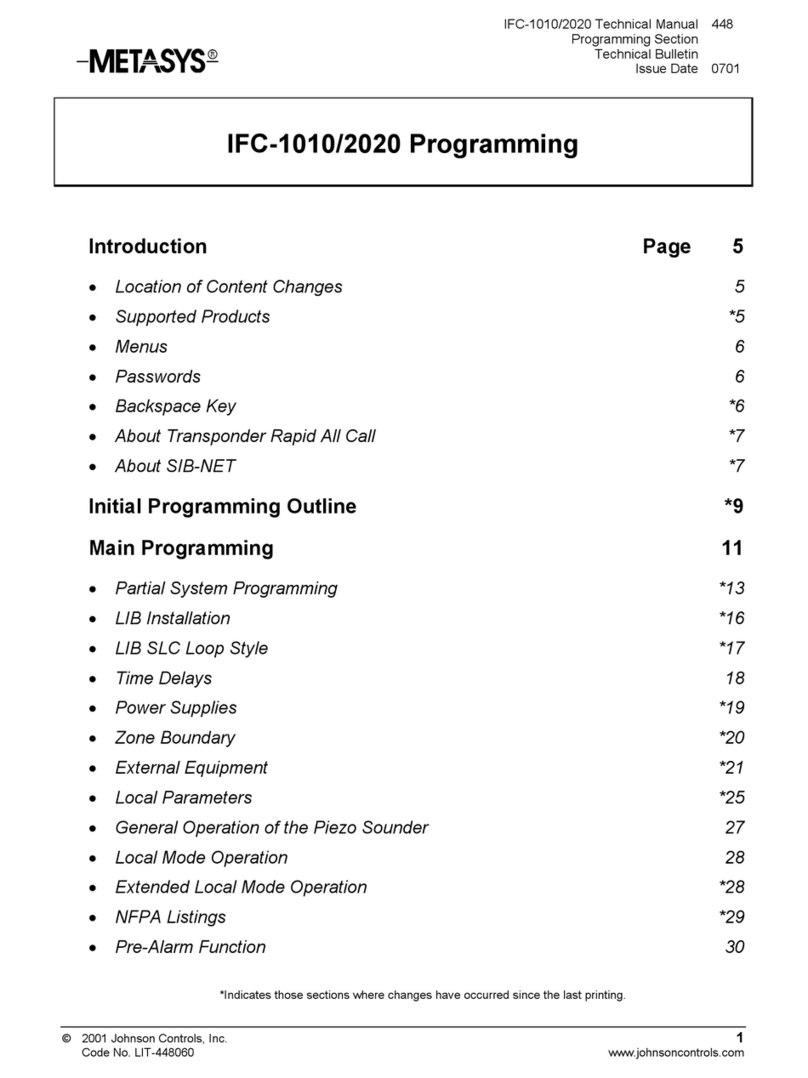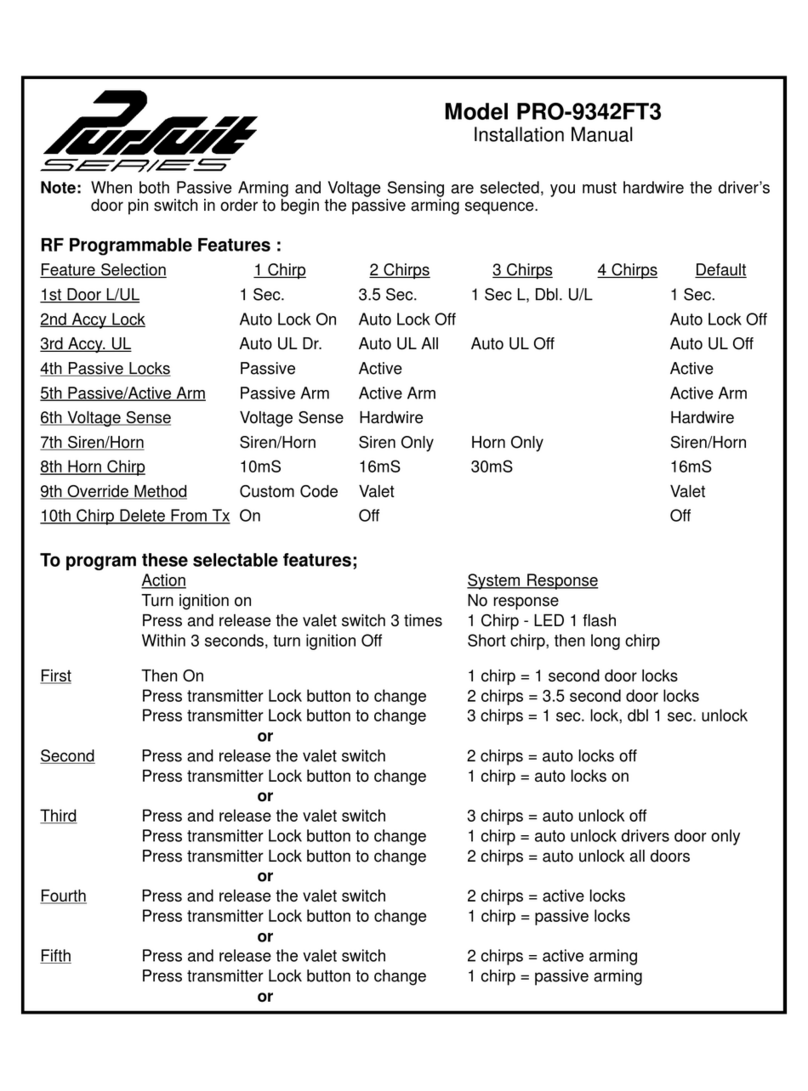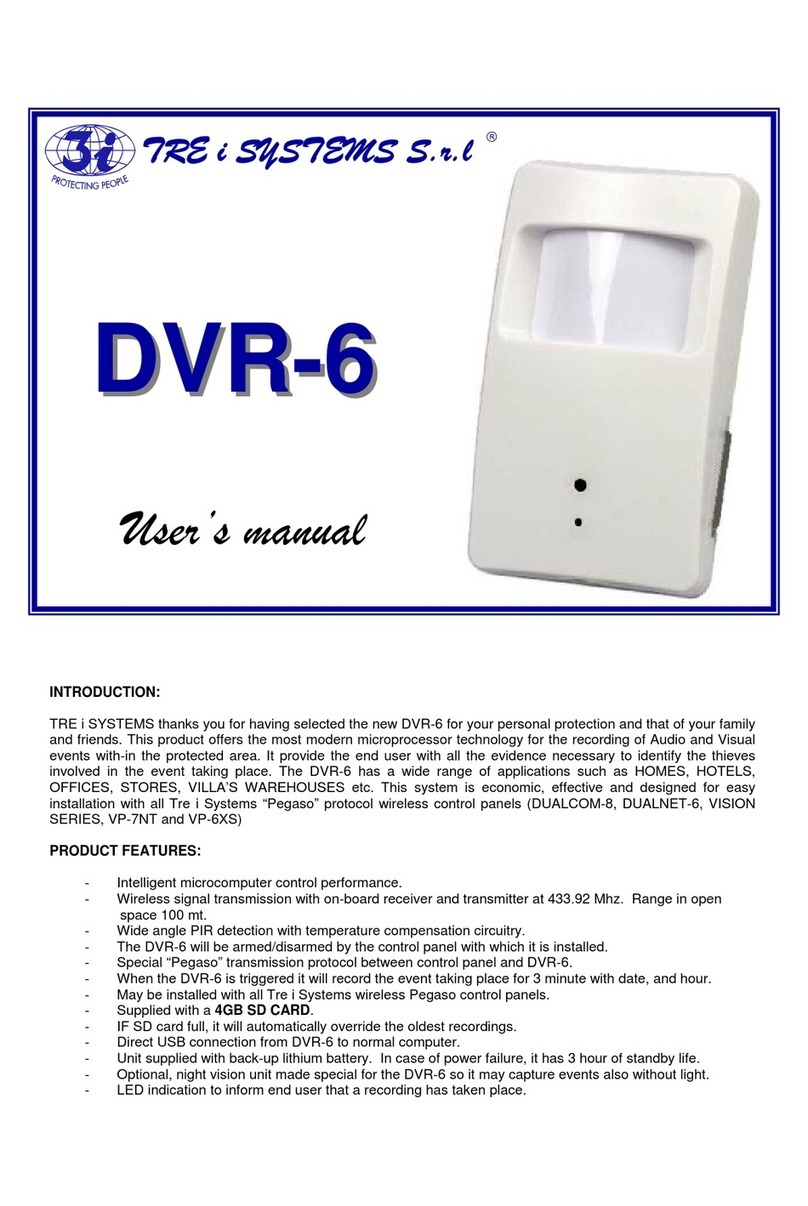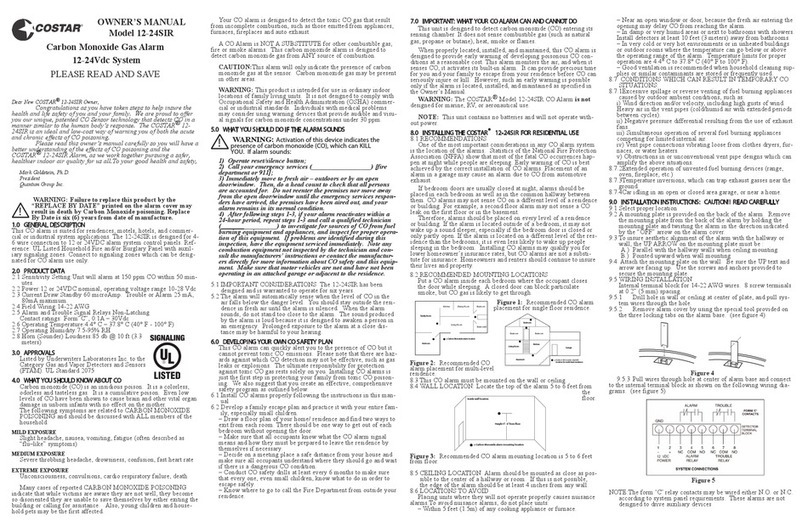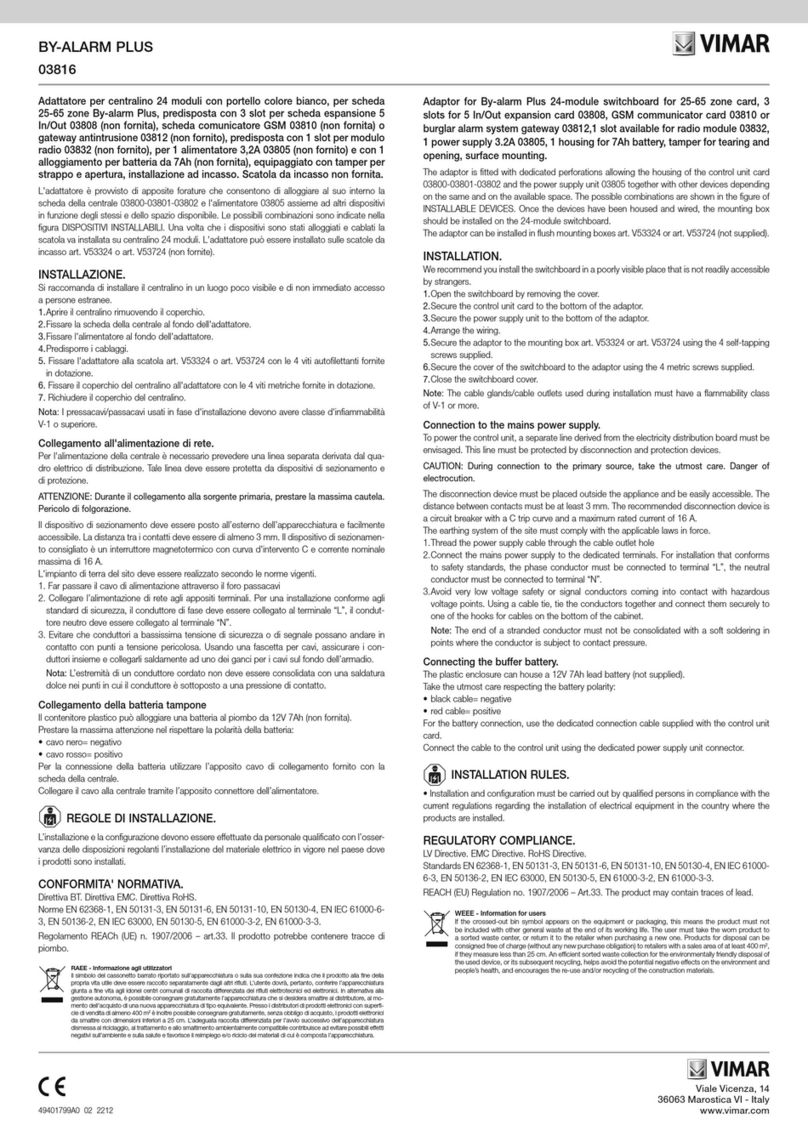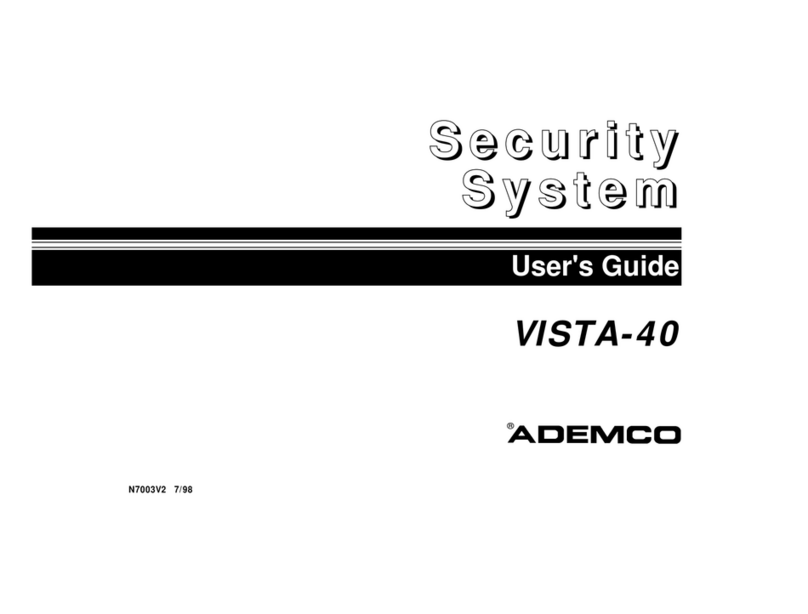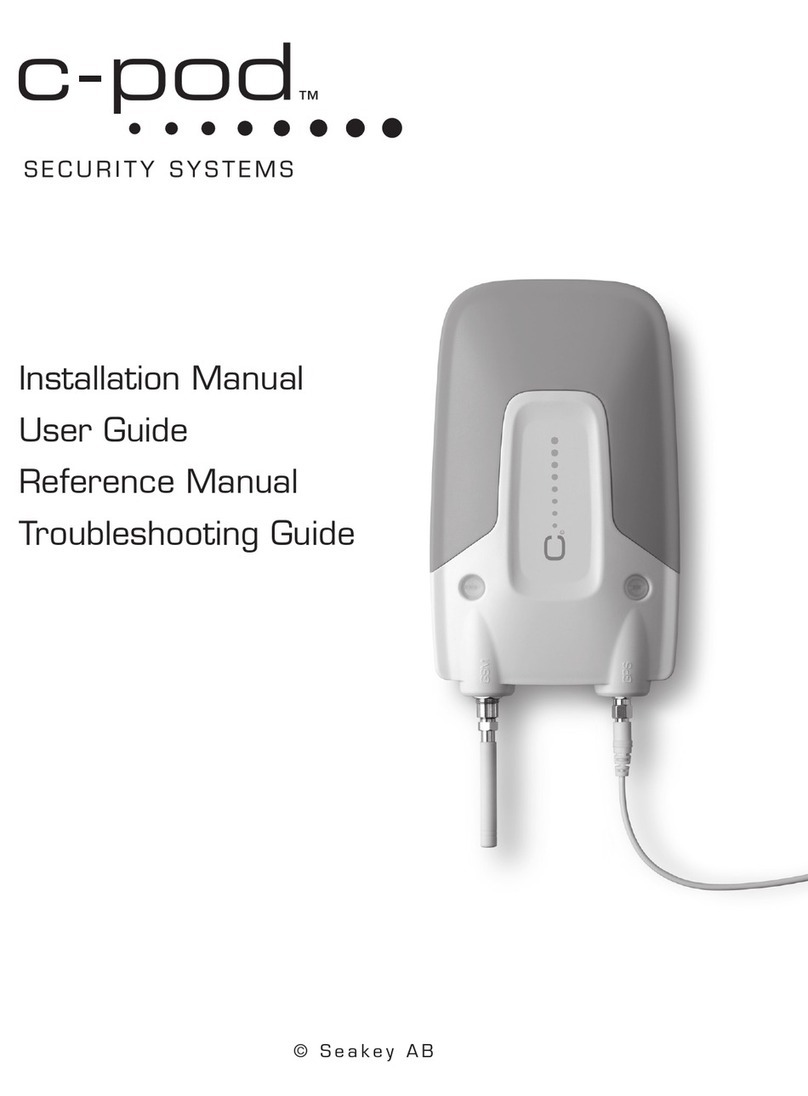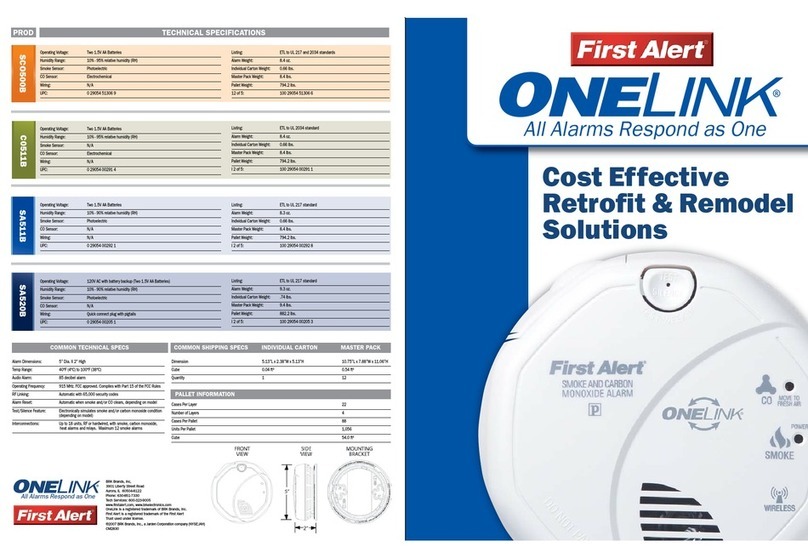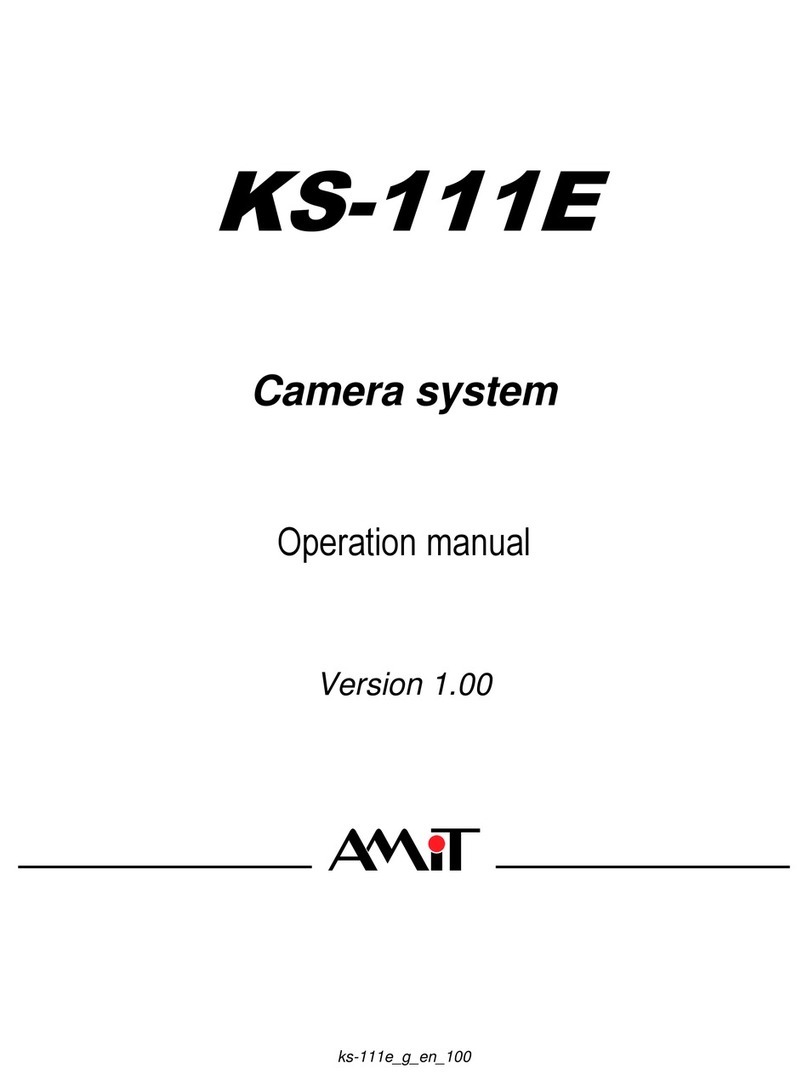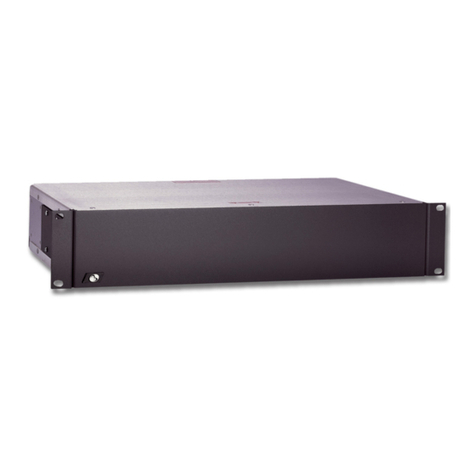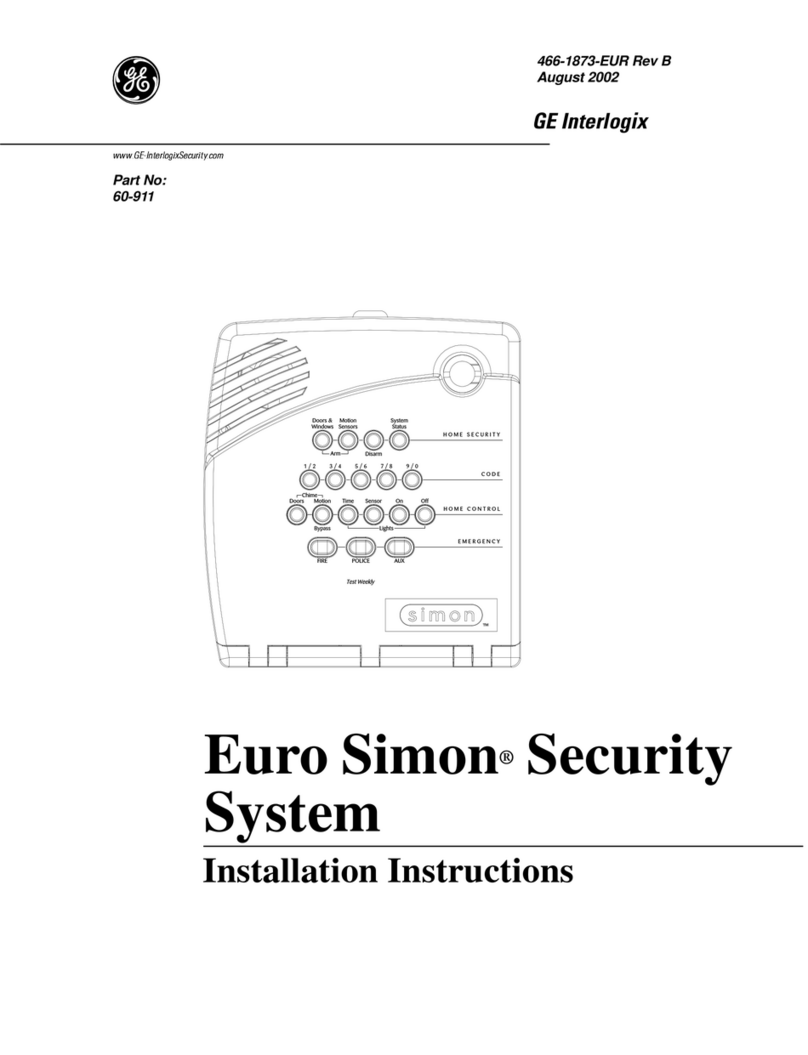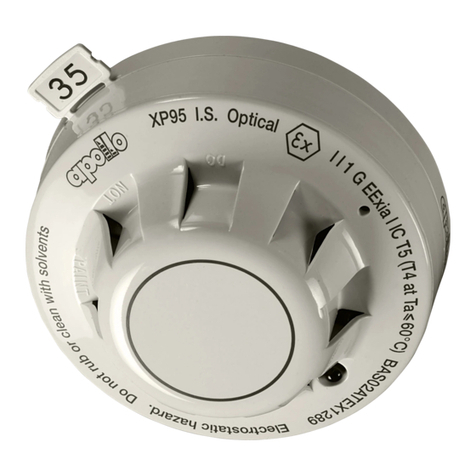Metasys IFC-1010 Instruction Manual

IFC-1010/2020 Technical Manual 448
Security Section
Technical Bulletin
Issue Date 1198
© 1998 Johnson Controls, Inc. 1
Code No. LIT-448300 www.johnsoncontrols.com
Installing and Programming Combination
Fire/Security Fire Alarm Systems Page 3
x
Introduction 3
x
Location of Content Changes 4
x
Supported Products 4
x
General Security Requirements 5
x
Security Configuration-Specific Requirements 6
x
Zone Programming 17
x
Connecting an RKS-S Remote Keyswitch 20
x
PPU Zone Programming 30
Application and Clarification Notes 37
x
Note 4 39
x
Note 5 44
x
Note 8 44
x
Note 10 50
x
Note 11 54
Security Applications

2Security—Security Applications

Security—Security Applications 3
Installing and Programming
Combination Fire/Security Fire
Alarm Systems
The IFC-1010/2020 is suitable for use as a Grade AA, Grade A, or
Grade B Central Station and Proprietary Burglar Alarm Protected
Premises and Receiving Unit when the installation and programming
requirements outlined in this section are followed. Such an installation
meets the requirements of Standards UL 1076 (Proprietary Burglar Alarm
Units and Systems) and UL 1610 (Central Station Burglar Alarm Units).N1
A Fire/Security Protective Signaling System includes:
xone or more Protected Premises
xone or more Central Stations
Security devices in such a system must be configured so unauthorized
activity in an area within the Protected Premises is communicated to the
Central Station. This communication will be handled in one of two ways,
depending on the characteristics of the location:
When the system consists of a single IFC-1010/2020, the system must
reside in the Central Station. Security devices are grouped together in
logical areas, and when activated, signal the operator at the Central
Station.
When the system consists of more than one IFC-1010/2020, a Protected
Premises Unit (PPU) IFC-1010/2020 equipped with a NIB-96 Network
Interface Board facilitates signaling over an SLC loop N2 to the
IFC-1010/2020 control unit at the Central Station. N12
This bulletin outlines security requirements for installations using a single
IFC-1010/2020 and installations using multiple IFC-1010/2020 units,
including optional features. Sample system configuration diagrams are
also included. Programming must be performed by an installer who is
proficient in programming the IFC-1010/2020. N4
Introduction

4Security—Security Applications
The product that this document supports is UL (Underwriter’s Laboratories)
Multiple Listed, which requires that the content of the documentation
inherited from the manufacturer remain intact. Minor changes clarify
information such as vendor-specific product names and literature names and
numbers. More significant changes to the original technical content, such as
additions or corrections, are identified with Note Numbers Nx. For the Note
Number content, refer to the Application and Clarification Notes section at
the end of this document.
This document may contain references to some products that are not
supported in Metasys® Release 9.01. If you are using this release, please
ignore references to the following products:
xNAM-232
xLIB-200A
xLIB-400
xSIB-2048A
Also, the AVPS-24 and AVPS-24E have been replaced by the APS-6R.
Location of
Content
Changes
Supported
Products

Security—Security Applications 5
The general security requirements are:
xFollow the instructions contained in this manual.
xThe MPS-24/MPS-24E power supply cannot be employed; an
MPS-24A/MPS-24AE must be used.
xShielded cable must be used on all input/output wiring associated with
security functions.
- SLC loop shielding. Refer to the Installing the IFC-1010/2020
Technical Bulletin (LIT-448155) for SLC loop shielding
requirements.
- Security module I/O circuit shielding. Terminate the shield at earth
ground at the junction box containing the module.
xWhen employed as a Protected Premises Unit, the IFC-1010/2020
cabinet door must be wired with an STS-1 Tamper Switch that is
monitored by the control panel.
xIf the system has arming and disarming capability, a ringback signal
from the Central Station to the arming location is required for
Grade AA or Grade A operation. The ringback signal informs the
Protected Premises Control Panel that the signal to arm/disarm has
been received by the Central Station.
xA single SLC loop may be used for both fire and security device
connections.
There are four software Type IDs associated with security operation:
SACM (Security Access Monitor), SARM (Security Area Monitor), SEQM
(Security Equipment Monitor), and SSYM (Security System Monitor), as
well as one software function, SDEL (Security Delay). These software
elements are essential to all aspects of security operation, including
Control-By-Event (CBE) programming. Devices with the Type IDs
SACM and SEQM do not automatically display at the LCD of the DIA, or
an LCD-80 or require state change acknowledgment. State changes in
devices with these software types may be output at a printer. For more
information about the characteristics of software Type IDs, refer to the
IFC-1010/2020 Programming Technical Bulletin (LIT-448060).
!
WARNING: XP Transponder circuits are not suitable for security
applications.
General
Security
Requirements

6Security—Security Applications
The following figures illustrate the minimum system requirements for
various configurations of the IFC-1010/2020 and associated peripherals:
Figure 1 illustrates the following system requirements:
xone IFC-1010/2020 control panel
xone security supervisory protected area
xone Protected Premises
xone M500MJ or M501MJ Monitor Module, security devices
(minimum security equipment)
secure1
Area 1
(
Perimeter
)
Motion Detector
Contact Switch
M500MJ or M501MJ
Securit
y
Area Monitor
1
2
9
8
7
6
5
IFC-1010/2020
Central Station
47K End-of-Line Resistor
(
A2143-00
)
Normall
y
Open, Listed
Securit
y
Switches
Normall
y
Closed, Listed
Securit
y
Switches
SLC to LIB-200 at Central Station
M500MJ or M501MJ
Securit
y
Area Monitor Module
1
SLC Loop
Pull Station
Smoke Detector
3
4
Figure 1: System Requirements
Table 1: Programming Key for Figure 1 N5
1
M50xMJ Security Area Monitor
Address LxxMyy (Installer specified).
Type ID SARM
Control-By-Event ( )
Custom Label Installer specified (describe location of module).
Tracking Yes - Results in required acknowledgment at Central Station for
every unsecured state. Restoral is automatic.
No - Results in required acknowledgment at Central Station for first
unsecured state only (until reset at Central Station - short condition
only).
Annunciator No (not required).
Security
Configuration-
Specific
Requirements

Security—Security Applications 7
Figure 2 illustrates the following system requirements:
xone IFC-1010/2020 control panel
xmultiple security supervisory protected areas
xone Protected Premises
xone M500MJ or M501MJ Monitor Module per protected area, security
devices (minimum security equipment).
Area 3
secure2
Area 1
(
Perimeter
)
Area 2
1
3
2
IFC-1010/2020
Central Station
SLC Loop
Motion Detector
Contact Switch
M500MJ or M501MJ
Securit
y
Area Monitor
Pull Station
Smoke Detector
Figure 2: System Requirements N6

8Security—Security Applications
Figure 3 illustrates the following system requirements:
xone IFC-1010/2020 control panel
xmultiple security supervisory protected areas
xmultiple Protected Premises
xone M500MJ or M501MJ Monitor Module per protected area, security
devices (minimum security equipment)
SLC Loop
Tenant B
Area 3Area 2
Area 3
Area 1
(
Perimeter
)
(
Perimeter
)
Area 1 1
2
3
2
1
3
IFC-1010/2020
Central Station
Motion Detector
Contact Switch
Pull Station
Smoke Detector
Ke
y
Tenant A
Area 2
Shaded Area Indicates Second Tenant
M500MJ orM501MJ Securit
y
Access Monitor
fig3
Figure 3: System Requirements N7

Security—Security Applications 9
Figure 4 illustrates the following system requirements:
xone IFC-1010/2020 control panel
xmultiple security supervisory circuits reporting to Central Station as a
single area
xsingle Protected Premises
xminimum security equipment:
- multiple M500MJ or M501MJ Monitor Modules per protected area
- one group interface consisting of a M5x0CJ N3 and an M50xMJ
module
- security devices

10 Security—Security Applications
fig4
Motion Detector
Contact Switch
M50xMJ Securit
y
Access Monitor
Group Interface*
*Group Interface must be ph
y
sicall
y
located in either the Protected
Premises or the Central Station.
Tenant A
Area 1
(
Perimeter
and
Interior
)
Group Interface*
SLC Loop
SLC Loop
from Central Station
Tabs on M5x0CJ
must be broken
when used as a
Form-C rela
y
.
COM
NO
SLC Loop
from Central Station
Tabs on M5x0CJ
must be broken
when used as a
Form-C rela
y
.
COM
NO
SLC Loop to Other Devices
Red
(
+
)
Black
(
-
)
Purple
Yellow
R-47 End-of-Line
Resistor
(
not supplied
)
1
Pull Station
Smoke Detector
Note:
Note:
M500MJ/M5x0CJ Wirin
g
M500MJ
M5x0CJ
M5x0CJ
M501MJ/M5x0CJ Wirin
g
(
Alternate to M500MJ/M5x0CJ
)
IFC-1010/2020
Central Station
Figure 4: System Requirements

Security—Security Applications 11
Table 2: Programming Key for Figure 4 N8
M50xMJ Security Access Monitor
Address LxxMyy (Installer specified).
Type ID SACM
Control-By-Event (Za*)
Custom Label Installer Option (describe specific location of module).
Tracking Yes - Each unsecured state and restoral will be printed when the
print option is enabled.
No - The first unsecured state will be printed when the print option
is enabled (restorals will not print until reset at Central Station -
short condition only).
Annunciator No (Not required).
*'a' is an installer specified number. In this example, all modules must be assigned the same
zone number.
Table 3: Programming Key for Figure 4
M5x0CJ
=
M50xML
Group Interface
A: M5x0CJ Programming
Address LxxMyy (Installer specified).
Type ID CMXC
Control-By-Event (Za*)
Custom Label Security Group Output
Signal Silence No
Walk Test Yes/No (Installer specified).
Annunciator No (Not required).
B: M50xMJ Programming
Address LxxMyy (Installer specified).
Type ID SARM
Control-By-Event ( )
Custom Label Installer Option (describe location of module).
Tracking Yes - Results in required acknowledgment at Central Station for
every unsecured state. Restoral is automatic.
No - Results in required acknowledgment at Central Station for
first unsecured state only (until reset at Central Station - short
condition only).
Annunciator No (Not required).

12 Security—Security Applications
Figure 5 illustrates the following system requirements:
xone IFC-1010/2020 control panel
xmultiple security supervisory circuits reporting to Central Station as
single area
xmultiple Protected Premises
xminimum security equipment:
- Multiple M500MJ or M501MJ Monitor Modules per protected
area
- one group interface per grouped area
- security devices
*
*
M500MJ or M501MJ Securit
y
Access Monitor
M50XMJ
M5X0CJ M5X0CJ
M50XMJ
M5X0CJ
M50XMJ
Motion Detector
Contact Switch
Pull Station
Smoke Detector
Ke
y
Tenant A
Tenant B
Group Interface*
* Group Interface must be ph
y
sicall
y
located in either the Protected
Premises or the Central Station.
Area 1
(
Perimeter
and
Interior
)
Area 1
(
Perimeter
and
Interior
)
IFC-1010/2020
Central Station
Shaded Area Indicates Second Tenant
SLC Loop
fig5
Figure 5: System Requirements
Programming relating to Figure 6 is essentially the same as Figure 5. The
only difference in programming is the (Za) Control-By-Event value for
Tenant A and (Zb) Control-By-Event value for Tenant B must be used,
where Za is zone number and Zb is a different zone number. N9

Security—Security Applications 13
Figure 6 illustrates the following system requirements:
xone IFC-1010/2020 control panel
xone security supervisory protected area
xone Protected Premises
xsystem Arm/Disarm capability with Central Station ringback signal
xminimum security equipment:
- M500MJ or M501MJ Monitor Module for protected area
- contact switch for entry/exit door
- RKS-S Remote Keyswitch
- M50xMJ Monitor Modules
- Model ACM-16ATx or Model ACM-32Ax Remote Annunciator
for entry/exit door
- security devices

14 Security—Security Applications
*
ACM-16ATx or ACM-32Ax Remote Annunciator
M50XMJ
M
5X0CJ
M50XMJ
M5X0CJ
fig6
S
y
stem
Status
(red is armed)
S
y
stem
Station Status
(red is armed)
Entr
y
/Exit Door
Status
(red is unsecured)
Area 1
Status
(red is unsecured)
*
Group Interface must be ph
y
sicall
y
located in either the Protected Premises
or the Central Station.
Sample Annunciator Displa
y
(
ACM-16ATx
)
Area 1
(
Perimeter
and
Interior
)
Motion Detector
Contact Switch
Pull Station
Smoke Detector
Ke
y
Group Interface*
=
Tenant A
SLC Loop
SLC Loop
To Central Station
(
via EIA-485 circuit
)
Entr
y
/Exit Door
IFC-1010/2020
Central Station
RKS-S Remote Ke
y
switch w/M50XMJ Module
M500MJ or M501MJ Securit
y
Access Monitor
ContactSwitch w/M50XMJ Module
Figure 6: System Requirements
Table 4: Programming Key for Figure 6
Contact Switch with M50xMJ Module
Address LxxMyy (Installer specified).
Type ID SACM
Control-By-Event (Zac*)
Custom Label Entry/Exit Door
Tracking Yes
Annunciator Yes
Annunciator Point AxxP3

Security—Security Applications 15
Table 5: Programming Key for Figure 6
RKS-S Remote Keyswitch with M50xMJ Module
Address LxxMyy (Installer specified).
Type ID NOA
Control-By-Event (Zab*)
Custom Label Arming Switch
Tracking Yes
Annunciator Yes
Annunciator Point AxxP1
Table 6: Programming Key for Figure 6
Model ACM-16ATx/Model 32Ax Annunciator
Annunciator Point Type ID
AXXP1 AMON
AXXP2 AZON
AXXP3 AMON
AXXP4 AMON
Table 7: Programming Key for Figure 6
M50xMJ Security Access Monitor
Address LxxMyy (Installer specified).
Type ID SACM
Control-By-Event (Zaa*)
Custom Label Installer Option (describe specific location of module).
Tracking Yes—Each unsecured state will be printed when the print option
is enabled.
No—The first unsecured state will be printed when the print option
is enabled (restorals will not print until reset at Central Station-
short condition only).
Annunciator Yes
Annunciator Point AxxP4

16 Security—Security Applications
Table 8: Programming Key for Figure 6
M50XMJ
M5X0CJ
Group Interface
A: M5x0CJ Programming
Address LxxMyy (Installer specified).
Type ID CMXC
Control-By-Event (Zaj*)
Custom Label Security Group Output
Signal Silence No
Walk Test Yes/No (Installer specified).
Annunciator No (Not required).
B: M50xMJ Programming
Address LxxMyy (Installer specified).
Type ID SARM
Control-By-Event ( )
Custom Label Installer specified
Tracking Yes - Results in required acknowledgment at Central Station for
every unsecured state. Restoral is automatic.
No - Results in required acknowledgment at Central Station for
first unsecured state only (until reset at Central Station - short
condition only).
Annunciator No (Not required).

Security—Security Applications 17
Zone Boundary: Must be less than Zad* and greater than or equal to
Zac*.
Table 9: Zone to Which All Instant Security Modules are Mapped
Zone Zaa*
Type ID FZON
Control-By-Event ( )
Custom Label Instant Group
Annunciator No
Table 10: Zone Activated Upon Arming System
Zone Zab*
Type ID FZON
Control-By-Event ( )
Custom Label Arming Zone
Annunciator Yes
Annunciator Point AxxP2
Table 11: Zone Activated When Entry/Exit Door is Open
Zone Zac*
Type ID FZON
Control-By-Event ( )
Custom Label Tenant A Entry/Exit
Annunciator No (Not required).
Table 12: Zone Activated When Any Instant Module is Violated
and the System is Armed
Zone Zad*
Type ID RZON
Control-By-Event AND(Zaa* Zab*)
Custom Label Installer specified.
Annunciator No (Not required).
Zone
Programming

18 Security—Security Applications
Table 13: Zone Active for 30 Seconds, 30 Seconds After Opening
Entry/Exit Door (Not Dependent on Door Closure)
Zone Zae*
Type ID RZON
Control-By-Event SDEL(00.00.30 00.00.30 (Zac*))
Custom Label Installer specified.
Annunciator No (Not required).
Table 14: Zone Active 1 Minute After Entry/Exit Door is Opened
and Left Open
Zone Zaf*
Type ID RZON
Control-By-Event DEL(00.01.00 (Zac*))
Custom Label Installer specified.
Annunciator No (Not required).
Table 15: Zone Active 1.5 Minute After Arming System
Zone Zag*
Type ID RZON
Control-By-Event DEL(00.01.30 (Zab*))
Custom Label Installer specified.
Annunciator No (Not required).
Table 16: Zone Providing 30 Seconds Entry/Exit Delay (Entry/Exit
Door Only) When System is Armed
Zone Zah*
Type ID RZON
Control-By-Event OR(AND(Zab* Zag* Zae*) AND(Zab* Zaf*))
Causes Zone Zah* to
activate if entry/exit time is
exceeded.
Causes Zone Zah* to activate if
entry/exit door is left open
Custom Label Installer specified.
Annunciator No (Not required).

Security—Security Applications 19
Table 17: Zone Active a Minimum of 30 Seconds if Entry/Exit
Delay is Violated (Entry/Exit Door Only) When System is Armed
Zone Zai*
Type ID RZON
Control-By-Event AND(Zab* SDEL(00.00.00 00.00.30 (Zah*)
Custom Label: Installer specified.
Annunciator No (Not required).
Table 18: Zone Active at Least 30 Seconds for Any Security
Breach While System is Armed
Zone Zaj*
Type ID RZON
Control-By-Event OR(Zad* Zah* Zai*)
Custom Label Installer specified.
Annunciator No (Not required).
When using an optional M5x0CJ for notification appliances intended to
indicate a security violation, this M5x0CJ may be programmed with the
following Control-By-Event equation:
AND (Zab* SDEL(00.00.00 00.15.00 (Zaj*))
resulting in 15 minutes of notification appliance activation after a security
violation.
* Zaa through Zaj are each unique installer-specified zone numbers. Zaa is
the lowest specified zone number (highest priority) and Zaj is the highest
specified zone number (lowest priority).
Example: N10
Zaa Zab Zac Zad Zae Zaf Zag Zah Zai Zaj
Z5 Z12 Z22 Z180 Z188 Z199 Z200 Z210 Z211 Z212
Forward Zones
Reverse Zones
Zone boundary greater than or equal to Z22 and less than Z180.
Notification
Appliance with
M5x0CJ Module

20 Security—Security Applications
The RKS-S Remote Keyswitch arms/disarms the system. It can be
mounted in a UL Listed single-gang electrical box. Both the M50xMJ and
RKS-S must be mounted within the protected area.N11
!
WARNING: XP Transponder circuits are not suitable for security
applications.
+
-
RKS-S
Front
RKS-S
Rear
Yellow
(
-
)
Purple
(
+
)
Red
Black
SLC Loop
M501MJ
Wire an R-47K End-of-Line
Resistor into the circuit.
rks1!
Figure 7: Connecting an M501MJ Module to the RKS-S
SLC Loop
Out
SLC
Loop
In
M500MJ RKS-S
Rear
Wire an R-47K End-of-Line
Resistor into the circuit.
Rks2!
Figure 8: Connecting an M500MJ Module to the RKS-S
Connecting an
RKS-S Remote
Keyswitch
Other manuals for IFC-1010
1
This manual suits for next models
1
Table of contents
Other Metasys Security System manuals
